Thanks to all the people who have contributed to this week’s newsletter: Aziza de Fazio, Helen Simpson, Jane Dyer, Jane Glynn, Jeremy Kesselbach, Jian Liu, Jonathan Warren, Karen Cheah, Karen Olsen, Karen Ye, Karin Motyer, Marjory Gardner, Stuart Muir Wilson, Velyne Moretti and Virginia Solomon.
Which farmer’s markets will be happening this weekend?
On Saturday: Carlton and Coburg. Yes, that’s right, Carlton Farmers’ Market has re-started! Not Bundoora Park.
On Sunday: Alphington and Eltham. Not Heathmont.
Food swap news
Pascoe Vale Food Swap has re-started and is on this upcoming Saturday (4th July): 11am-1.30pm, Gavin Park (BBQ area), Pascoe Vale. Welcome Leila and Lisa!
North Coburg Food Swap has also re-started, with the next swap on 18th July.
The Diamond Village Food Swap in Watsonia is no more. Well done to Ken Johnson and others for keeping it going over the years.
Local food producer news
The Mushroom Shed had some homegrown ginger for sale at last Sunday’s Eltham Farmers’ Market. This apparently surprised some people who assumed that the Melbourne climate is unsuitable for growing it. As I know because I grow it every year, there is actually no problem growing ginger in Melbourne so long as you grow it in a pot. Plant in Spring, move the pot into your greenhouse or equivalent in Winter and harvest the following Winter (when it dies back). Ditto turmeric. Ditto galangal. Helen Simpson, joint proprietor of The Mushroom Shed, actually wrote an article for our website some years ago on how to grow ginger and turmeric in Melbourne.
Jane and Peter Dyer from Backyard Honey have just had a paper entitled A BeeC’s: changing our thinking to changing the world published in the UNESCO Observatory Multi-Disciplinary eJournal in the Arts.
Jian’s worm farm tips
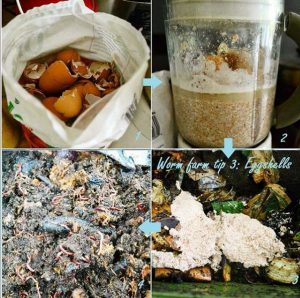 Jian Liu, from Camberwell, has written an article for our website on worm farms. The material starts by discussing 3 key questions: Why bother? How much work is it? How much is it going to cost me? It then goes on to provide Jian’s top 10 tips for fostering happy, blissful worms. As you might guess if you have read Jian’s previous article on ponds, the material is both comprehensive and comprehensible plus there are lots of pictures of her set up.
Jian Liu, from Camberwell, has written an article for our website on worm farms. The material starts by discussing 3 key questions: Why bother? How much work is it? How much is it going to cost me? It then goes on to provide Jian’s top 10 tips for fostering happy, blissful worms. As you might guess if you have read Jian’s previous article on ponds, the material is both comprehensive and comprehensible plus there are lots of pictures of her set up.
Here are Jian’s 10 top worm farm tips:
- Location, location, location.
- Give your worms nice bedding to sleep in.
- Balance.
- Not too wet, not too dry.
- Keep me warm but not too hot.
- Don’t feed me too much.
- Feed me right.
- Avoid large amounts of acidic products.
- Eggshells!
- The fun part, harvesting worm poo!
Want a paid job?
3000acres General Manager
General Manager at 3000acres. Full-time. $75-80K pa. Located in Alphington. Closing date: 21st July. Read more and apply.
At the Jesuit Social Services Ecological Justice Hub
They have 5 full- or part- time positions available at the moment. To view these positions, you have to register as a ‘sidekick’ on the Sidekicker website. When registering, check the box for environmental labouring.
Yes, you did know!
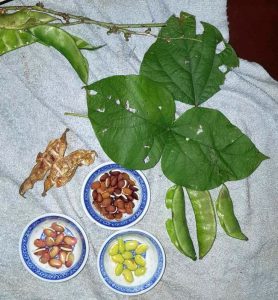 After last week’s prodding, four people wrote in identifying Stella’s legume as a hyacinth/lablab bean (Lablab purpureus). Thanks Jeremy, Jonathan, Karen C and Karen Y. It is people responding like this which really improves this newsletter.
After last week’s prodding, four people wrote in identifying Stella’s legume as a hyacinth/lablab bean (Lablab purpureus). Thanks Jeremy, Jonathan, Karen C and Karen Y. It is people responding like this which really improves this newsletter.
Here are some relevant links: How to grow hyacinth or lablab beans (video), how to grow hyacinth been vines, fair dinkum seeds and Wikipedia.
Karen Ye says “In Asia, we eat them properly cooked. The raw ones may be poisonous.” According to Wikipedia: the fruit and beans are edible if boiled well with several changes of the water (otherwise, toxic); the leaves can be eaten raw or cooked like spinach; the flowers can be eaten raw or steamed; the root can be boiled or baked; and the seeds can be used in tofu or tempeh.
No, you didn’t know
Last week, Darryl Wilson asked if anyone know of any courses in medicinal plants so that he could potentially help his paraplegic brother-in-law. No one responded, perhaps because hardly any face-to-face courses are currently happening because of COVID-19. But it is clear that there are lots on online courses (just Google “medicinal plants courses”). Anyone got any recommendations? Email me.
Dealing with oxalis
Thanks to everyone who has offered to help Susan out. Thanks also for the following contributions.
Virginia Solomon: “I have the same problem, it is seasonal. I recommend against attempting to dig up all the little bulbs. It is very difficult and just spreads the problem. Rather, pulling the tops off the oxalis will set it back for the season.
“One method that works on large areas (i.e. where you don’t have other precious herbaceous things growing in the same area) is a 1:1 mixture of brown vinegar and water. I have not yet tried to see if white vinegar works too, but it probably does. Just bog standard $2 for 2 litre stuff. Spray on a dry day and try to get most leaves. When the first lot go black and shrivel, do it again on the ones that were hiding. Works a treat, although looks a bit unsightly. My experience is that the bulbs do not die immediately, but they look weaker and yellower the following year. I have done it for 2 years and am still battling!“
Karen Olsen: “Hand weeding of Oxalis will usually just spread it further! The most common species has tiny bulbils along the roots which will just love being left in the ground when the rest of the plant is weeded -a perfect reproduction mechanism. One of the better methods of eradication is to wait until oxalis in full flower (later winter) and then exclude light (i.e. use black plastic to exclude light and water for several months until its dead). Or remove the whole of the soil it is in.
“Also, my understanding is that oxalis is edible, which could help reduce, or at least re-frame, the problem. And, speaking of re-framing, it’s a fantastic nitrogen-fixing form of green manure, so there is some enjoyment factor to be had for gardeners.“
I also wrote in myself(!): “Oxalis is a large genus of plants (c600 species), commonly called wood sorrels, and most of the species are not considered to be weeds. For example, I have Oxalis purpurea in my lawn; its pretty, little, purple flowers appear in late Autumn every year and it’s not a problem in any way. The weed is, I think, Oxalis corniculata, or common wood sorrel.“
Guy’s veggie growing tip – seed germination
Here are a few thoughts that you might find helpful.
Traditionally, people divide vegetable seeds between those that you should plant directly where they will grow (‘sow direct’) and those which you should initially plant in seed trays, with subsequent transplantation after they become seedlings. Direct sowing is traditionally preferred for both big seeds (e.g. beans, pumpkin), on the positive grounds that they will germinate anyway, and for root crops (e.g. beetroot, carrot), on the negative grounds that they resent transplantation. Our planting guide lists the traditional planting method for each vegetable. My experience, however, is that I get better germination for just about all seeds if I plant them in seed trays in my greenhouse because I can control the environment better.
Some seeds germinate better if they have been pre-soaked overnight beforehand. My list here is beetroot, broad beans, capsicum, celery, chilli, okra, parsley, silverbeet and spinach. I think that it is for different reasons for different seeds and I just follow the rules.
Different seeds can be very different sizes but the same rule of thumb for planting depth applies to them all: 2-3 times the seed diameter.
Seed germination does not require fertiliser or other sources of NPK. Rather, initial germination requires water (to activate the relevant biochemical processes), oxygen (to break down the seed’s food store) and a physically friable medium (to grow through). So, I water my seeds every day (gently) and I plant them in a very light mixture of coir and sieved compost. Once the plant has germinated, its initial, main requirements are light, carbon dioxide and water so that the first (cotyledon) leaves can photosynthesise.
In passing, I think that we can sometimes mislead ourselves when we anthropomorphically apply our thinking and terminology to plants. For example, when talking about fertiliser and other sources of NPK, we often use the term ‘food’. But plant ‘food’ is more carbon dioxide and water, with NPK being more like ‘vitamins’.
Read more of Guy’s veggie growing tips.
Meg’s social isolation week
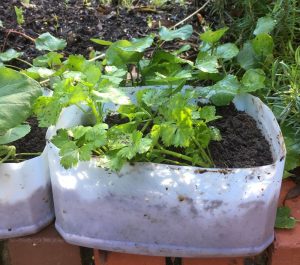 A friend has left a gift of lush seedlings on my doorstep today. He’d grown them from seed grown in the cut off ends of three litre milk bottles. The seedlings included celeriac (see photo) and Romanesco broccoli, both good for winter growing in Melbourne. I spent the afternoon planting them out in the veggie patch along with some rocket seeds.
A friend has left a gift of lush seedlings on my doorstep today. He’d grown them from seed grown in the cut off ends of three litre milk bottles. The seedlings included celeriac (see photo) and Romanesco broccoli, both good for winter growing in Melbourne. I spent the afternoon planting them out in the veggie patch along with some rocket seeds.
We have been harvesting rocket, rocket and more rocket over the past few weeks. I’ve decided that you can never have too much rocket and a winter salad goes well with individual beef in red wine with thyme pies. I break off some sprigs of thyme to serve as I head inside out of the cold.
Basic beef in red wine with thyme
Makes six small oven proof ramekins or one larger pie dish.
1kg diced beef rump (or similar, cheaper cuts may need longer cooking)
375ml beef stock
2 teaspoons olive oil
1 large brown onion
2 cloves of garlic crushed
2 tablespoons tomato paste
375ml red wine
200g mushrooms
2 tablespoons plain flour
2 carrots diced
2 tablespoons each of fresh thyme and parsley
plus 6 sprigs of thyme extra
2 sheets puff pastry
milk to glaze
In a heavy pan or pot, cook the onion in oil over a low heat until translucent.
Add the garlic and beef to brown.
Add the flour, stock, tomato paste and red wine and bring to boil.
Reduce to simmer and add the remaining vegetables and the thyme.
Cover with a lid and simmer 30 minutes.
Remove the lid and cook for another 30 minutes until thickened.
Stir through the parsley and divide the mixture into ramekins to cool.
When cooled, cut the puff pastry into squares and cover. Cut a small cross in the middle of the pastry and insert the thyme sprig. Glaze the pastry with milk. Bake for 20-30 minutes in oven at 200degC.
Read more of Meg’s recipes on our website.
Reader photos
Last week’s theme – garden tools
4 people submitted a total of 6 photos.
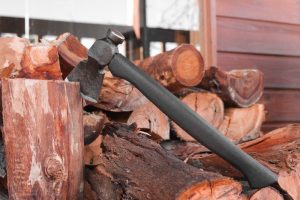 |
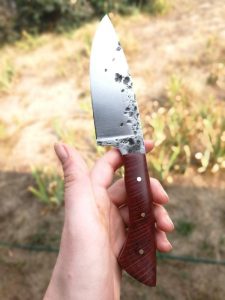 |
 |
| Aziza de Fazio | Aziza de Fazio | Aziza de Fazio |
 |
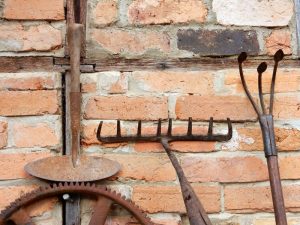 |
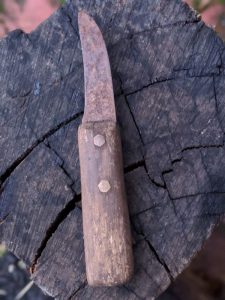 |
| Jo Douglas | Karin Motyer | Velyne Moretti |
Aziza de Fazio: “The first photo is an axe that my 15-year-old son Aidan forged yesterday. The next two photos are knives that he hand-crafted as custom orders (a bush-craft knife and a kitchen knife).“
Karin Motyer: “The oldest garden tools we could find in the garden shed at Montsalvat. From left to right: hand weeder, rake with 6 teeth missing and cultivator.“
Velyne Moretti: “This little tool was my grandpa’s. I think that he may have made it to cut lettuces with. I have kept it and used it for many years.“
The theme from ages ago – autumn leaves
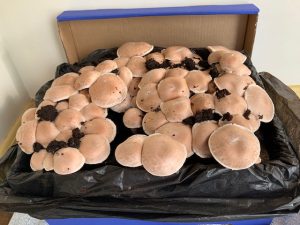 Some time ago, Marjory Gardner won a mushroom kit for her photo of Autumn leaves. Well, her mushrooms have now matured (see photo) and she had mushrooms on toast for Saturday lunch!
Some time ago, Marjory Gardner won a mushroom kit for her photo of Autumn leaves. Well, her mushrooms have now matured (see photo) and she had mushrooms on toast for Saturday lunch!
This week’s theme – winter flowers
This week’s photo theme will be ‘winter flowers’. Send me your interesting photos, together with a title and (if you want) a story, and I will publish them next week.
Which link was clicked most times in the last newsletter?
Stuart and Kelli Lewien’s garden in Heathmont.
Joke of the week
What did the rabbit say to the carrot? It’s been nice gnawing you..
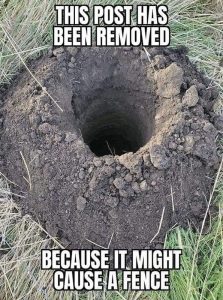 The picture comes from the Warrandyte Garden Facebook Group, which is one of the more active local gardening groups on the Internet.
The picture comes from the Warrandyte Garden Facebook Group, which is one of the more active local gardening groups on the Internet.
Upcoming online events
If you know of any events other than those listed below, email me.
Newly announced events
Understanding and improving your soil: Saturday, 11th July, 10.30-11.30am; $20; organised by BAAG. Read more and book on WeTeachMe.
Previously announced events
Culturing fungi on agar for beginners: Sunday, 5th July, 2-3.30pm; $28; organised by MYCOmmunity. Read more and book on their website.
Fire and fungi: Thursday, 16th July, 6.30-7.30pm; $25 (recommended donation); organised by MYCOmmunity. Read more and book on their website.
Backyard beekeeping basics: Tuesday, 28th July, 7-9pm; $50; organised by CERES. Read more and book on Humantix.
Open Table now offer their weekly no waste cook club workshops free and online on Saturdays. As well as cooking (which is actually optional), you will learn about food waste and composting. Register on EventBrite.
Whitehorse Council are publishing on their Youtube channel a video each Monday at 9am on various aspects of sustainability, including beeswax wraps (on 22nd June).
Newsletter reader Chloe Thomson is doing free, weekly podcasts on gardening for Bunnings.
Pip Magazine (some of whose journalists live in North East Melbourne) are producing a series of videos entitled simple skills for self sufficiency.
Good Life Permaculture are producing a series of videos entitled crisis gardening.
All The Dirt is a weekly podcast about gardening.
